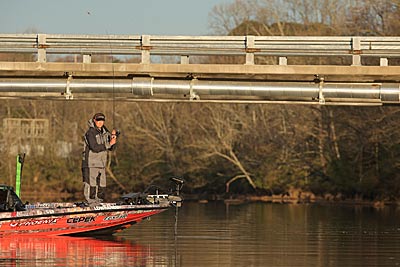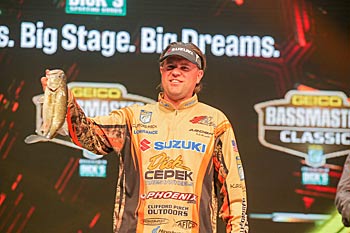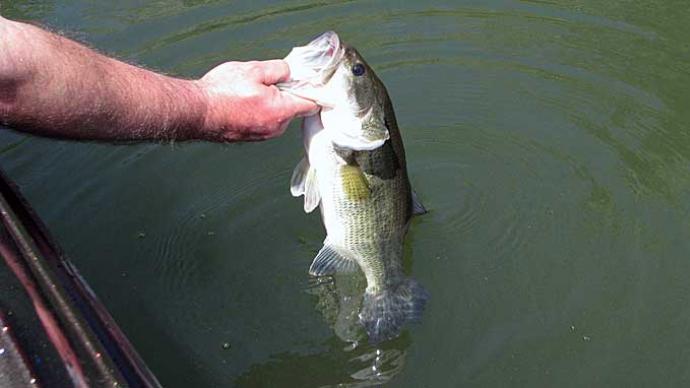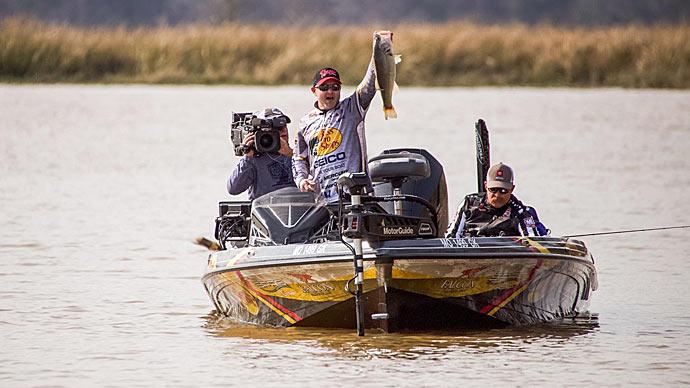
Bass tournament competitors are familiar with this saying: Anglers at the top of the standings fish more and run around less than those toward the bottom. While tournaments held on expansive bodies of water, such as the lower Mississippi River or Winyah Bay in South Carolina, are often the exception, the above statement holds true at most events.
Committing to a spot is easy if its bass are biting. But that becomes more difficult to do when they stop. So, how do you keep catching them? If you know that there are more there to mine, then half your work is done. All that’s left is digging around in your assembled bag of tricks to find something that makes them bite again.
Bassmaster Elite Series angler Shane Lineberger said generating a few more bites can add up to a lot at the end of the day. And tournament anglers aren’t the only ones who benefit from that. Fishing is always more fun when getting more bites, regardless of why you’re on the water. Here’s how to accomplish that.
Change your lures
Lineberger’s home lake is Norman. It’s the largest in North Carolina, making it one of the busiest. It’s common for several tournaments to be held simultaneously, any day of the week. That puts its bass under a steady stream of fishing pressure. He knows most spots hold more bass than the few aggressive ones quickly picked off. So, he turns around and heads back through spots with a finesse presentation. Bass see its subtle size, action, and color as more natural, making them more inclined to eat it.
Bassmaster Elite Series angler Cliff Pirch also takes the finesse route when he needs more bites from a spot. “I typically downsize line, baits, lures, and [fish] slower and possibly deeper or shallower,” said the Payson, Ariz.-pro. “I’m looking for [bass] that have been missed or didn’t bite on the first pass on a bigger or faster bait for some reason.”

Changing your lure’s color is an option, but Pirch said that’s most effective with faster-moving lures. So, when it comes to finesse presentations, he sticks with what works. While his tackle collection includes soft-plastic lures in hundreds of colors, they don’t all work at the same time or place. “I have a handful that seems to work in each region of the country,” he said. “I don’t get crazy with [switching colors]. In general, it’s a technique change. If I went through with a power-style technique, I might want to go back through with a worm or drop shot.”
Stay in the zone
Pirch is particular about his preparation. “I’ve always got some finesse-style setups along with whatever [primary lure] I use, whether it be a drop shot, weightless worm, wacky worm, Ned worm, or jig-head worm,” he said. But what he picks up is based on what he fishes first.
Specific lures catch bass best at certain depths. “If a [vibrating jig] is working, then [bass] are in the upper water column,” Pirch said. So, with bass shallow, or even on the top of submerged cover such as aquatic vegetation, he wants his second offering to work that depth, too. His choices for that scenario include a wacky-rigged weightless worm or Neko rig.
Pirch plays the same matching game when fishing deep-water structure, such as ledges, points, and humps, with a crankbait. If he’s confident that the spot holds more bass, but they aren’t interested in his faster-moving offering, he goes back over the spot with a jig, drop shot, or Ned rig.
Change your speed
A different lure isn’t the only key that turns bass with lockjaw into biters. Pirch said some bass may want the same color and size lure but fished at a different speed. And they’ll tell you to go slower or faster.
If a bass bites your lure when it’s sitting on the bottom while you’re fumbling through a compartment for a snack, Pirch said that’s a sign you need to slow down. There are more bass around, but they aren’t interested in chasing your lure.
Bass will dare you to retrieve your lure faster some days. “You might find that you get [a bass] that chases your bait out when you reel in quickly,” he said. “Then you’ll know a faster retrieve is triggering them.”
Change your approach
Sometimes generating more bites starts before you even make a cast. There are days when bass bite no matter what you do. But on the rest, they’re sensitive to your presence, and spooked bass are hard to catch. So, attack cover and structure with a plan that lets you catch as many as possible.

Most anglers have their preferred approach to a piece of cover or structure, and Pirch is no different. “I like not to drag a big one out of the heart of [the cover], over the top of the [bass holding] on the edge,” he said. “So, I often try to ease my way into it.” That’s the approach, whether he’s fishing a big laydown or a bed of aquatic vegetation. “If I am on a 50-yard stretch of grass, there is no need to cast to the other end of it and get a bite and drag it through the whole thing and spook the other fish,” he said. “If you catch a 5-pounder on the back side of it, you must drag it through it. You probably trashed everything you dragged your fish through. It’s better management to get the most out of it. I’m more of a dissect it type of guy. I might pick every branch, every pad stem, every hole in the grass on the way through it.”
Boat control is vital as you approach, or stay away from, spots. For example, you’ll want to keep your boat farther away in clear water, eliminating any noises or shadows that may spook bass. Be careful on windy days and current, both of which can push your boat onto productive stretches, killing the bite. When you stop to work on your tackle, pay particular attention to that possibility.
Change your location
Sometimes, staying on a spot is a losing proposition, regardless of how many lures or approaches you throw at them. Pirch’s decision to stay or go comes down to how he’s fishing, how many fish he believes remain, and how big they are. “If [the fishing] is hard and you feel like there is more fish there, then it’s worth doing,” he said. “But it can be a hindrance.”
Pirch only has to recall the Bassmaster Elite Series’ visit to Lake Hartwell in April 2019 for an example of when he should have left a spot. The fishing conditions were perfect. The more than 56,000-acre impoundment of the Tugaloo, Savannah, and Seneca rivers along the South Carolina-Georgia line was warming, and bass were flooding the banks to spawn.
Most of Pirch’s fellow competitors found plenty of largemouth and spotted bass willing to bite. Pirch was no exception. So, he decided to stick with them during the tournament instead of hunting for new spots. But that backfired. “It took me a lot of time to catch 20 little spotted bass that didn’t help me out. In the long run, I needed ten more ounces to be fishing [on Day 3]. I wish I had just gone on.”




